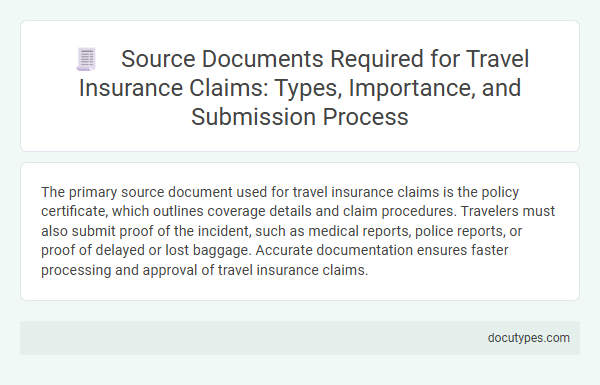The primary source document used for travel insurance claims is the policy certificate, which outlines coverage details and claim procedures. Travelers must also submit proof of the incident, such as medical reports, police reports, or proof of delayed or lost baggage. Accurate documentation ensures faster processing and approval of travel insurance claims.
Introduction to Source Documents for Travel Insurance Claims
Source documents are essential for processing travel insurance claims accurately. These documents provide proof of expenses, incidents, and losses during a trip.
Common source documents include travel itineraries, medical reports, police reports, and receipts for expenses such as accommodation, transportation, and medical treatment. Insurers require these documents to verify the authenticity of claims and ensure appropriate reimbursement. Collecting and submitting accurate source documents can significantly speed up the claims process and reduce the risk of claim denial.
Essential Types of Documents Needed for Claims
Travel insurance claims require specific source documents to validate and process the claim efficiently. Understanding these essential documents helps streamline the reimbursement procedure and avoid delays.
- Travel Itinerary - Confirms the travel dates, destinations, and transportation details, proving the insured trip occurred.
- Proof of Payment - Includes receipts or credit card statements that verify the purchase of travel services or insurance coverage.
- Medical Reports - Provides official documentation of injuries or illnesses sustained during travel, necessary for health-related claims.
Importance of Accurate Documentation in Claim Approval
The primary source document used for travel insurance claims is the insurance policy itself, which outlines coverage details and claim procedures. Accurate and complete documentation, such as medical reports, receipts, and proof of travel, is crucial for claim validation.
Precise documentation ensures faster claim approval and reduces the risk of disputes or denials. Maintaining thorough records during travel safeguards travelers against unexpected financial losses and supports transparent communication with insurance providers.
Commonly Required Proofs: Medical, Accident, and Theft
| Source Document | Description | Purpose in Travel Insurance Claims |
|---|---|---|
| Medical Reports | Official medical records from hospitals, clinics, or doctors detailing diagnosis, treatment, and medical procedures. | Verify medical expenses and justify claims related to illness or injury during travel. |
| Accident Reports | Documentation from local authorities or emergency services describing the accident circumstances and impact. | Support claims involving bodily injury or accidents occurring during the trip. |
| Police Reports (Theft) | Formal report filed with law enforcement detailing stolen items, time, location, and incident specifics. | Establish proof of theft for reimbursement of lost or stolen personal belongings. |
Submission Process: Step-by-Step Guide
What source document is required for travel insurance claims submission?
The primary source document used for travel insurance claims is the completed claim form provided by the insurer. This form must be accompanied by relevant supporting documents such as medical reports, receipts, and proof of travel to ensure a smooth submission process.
How do you begin the travel insurance claims submission process?
Start by gathering all necessary documents including the original insurance policy and evidence of the incident. Carefully fill out the claim form with accurate details to avoid delays in processing.
What documents are essential to attach with the travel insurance claim form?
Essential attachments include medical certificates, repair invoices, police reports if applicable, and travel tickets. These documents substantiate the claim and verify the occurrence of the insured event.
Where should the completed travel insurance claim form be submitted?
Submit the completed form and supporting documents directly to the insurance provider's claims department. Most insurers allow submissions through online portals, email, or physical mail depending on their policies.
What happens after submitting the travel insurance claim documents?
The insurance company reviews the submitted documents to verify coverage and validate the claim. Claimants may be contacted for additional information or clarification during this assessment stage.
Tips for Organizing and Storing Travel Documents
Travel insurance claims require specific source documents to validate your expenses and incidents. Proper organization and safe storage of these documents can streamline the claims process.
- Keep all receipts and invoices - These are crucial for proving payments related to medical treatment, accommodation, or transportation changes during your trip.
- Store digital copies securely - Use cloud storage or encrypted apps to back up electronic versions of your passport, insurance policy, and claim forms.
- Maintain a dedicated travel document folder - This helps you quickly locate tickets, boarding passes, and insurance cards when needed for filing claims.
How to Obtain Replacement Documents Abroad
The primary source document used for travel insurance claims is the original travel itinerary or proof of travel, such as flight tickets, boarding passes, or hotel booking confirmations. These documents validate the trip details and support reimbursement requests.
To obtain replacement documents abroad, contact your airline, hotel, or travel agency directly through their customer service channels. Request digital copies of your boarding passes, booking confirmations, or receipts, which can be emailed or accessed via their online portals.
Avoiding Common Documentation Mistakes
Travel insurance claims require specific source documents to ensure smooth processing and reimbursement. Proper documentation helps avoid delays and claim denials.
- Travel Itinerary - Confirms travel dates, destinations, and purchased trip components necessary for verifying claim validity.
- Medical Reports - Provides detailed evidence of injury or illness incurred during travel, essential for health-related claims.
- Receipts and Invoices - Supports proof of expenses such as emergency services, accommodations, and transportation fees.
Reviewing all submitted documents carefully reduces common errors and accelerates successful travel insurance claims.
Digital vs. Physical Documents: Pros and Cons
Travel insurance claims typically require a source document such as your travel itinerary, receipts, or medical reports. Digital documents offer easy access and faster submission, while physical documents provide tangible proof that may be required for certain claims. Understanding the pros and cons of both formats helps ensure a smoother and more efficient claims process.
What Source Document Is Used for Travel Insurance Claims? Infographic

